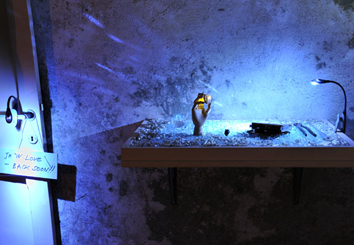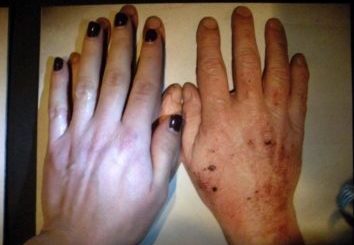Leibniz
Ghost Letters
play video >


installation performance: 120 mins; video documentation extracts above – 20 mins.
Main images at top: Manuel Vason; smaller image: Annalaura Alifuoco
From the original Festival website:
An installation of miniature landscapes/scenarios, restaging memories of previous performances as well as personal experiences of love, loss and longing, which moves across the room on free-standing butler trays, constantly making and unmaking itself and in the process tracing the imaginary history of LEIBNIZ performance collective.
Ghost Letters might be read as a simultaneously decadent and generative testament to the concept of performance-as-documentation-in-process that both recalls and erases the matter of its previous manifestations in order to construct ‘new’ narrative traces and combinations. The underlying aim of such spectral writings is to build a portfolio of performances – an assembly of ghosts – that speak intimately to each other and to their spectators of friendship, community and remembrance.
Two performers construct three-dimensional images on the above mentioned trays, using sand, flour and other small-grained detritus, model figures, domestic utensils, comestibles, souvenirs and gift items, while linking each tray/scenario – with a gesture, an object, a thematic reference – to its neighbours on either side. Already constructed images are digitally captured (either in their entirety or in detail) by a professional photographer, who then produces one print (per tray) of their choice for instant exhibition. Meanwhile, a third performer removes and clears the trays, preparing them, as well as the various objects and materials, to be used again (certain images might be repeated with variations or in different combinations).
At the end of a pre-determined time period (approx. 2 hours) the activity ceases, the installation has disappeared and all that is left are the photographs and a ‘dusting’ of materials, which have escaped the constraints of the trays and now mark out new territories on the floor.
LEIBNIZ is a fluid collective of international performers and was formed in 2005 by Ernst Fischer (Roehampton University) and Helen Spackman (London Metropolitan University) in order to present large-scale, socially engaged work, generate new audiences and assist emerging artists. Having worked together since 1995, Fischer & Spackman’s initial focus on gender issues has shifted to wider body-political concerns of human rights, migration and urban alienation. While both directors continue to pursue individual performance and directing projects, LEIBNIZ has so far produced three distinct pieces of work:
The Book of Dust (2005-)
The Ship of Fools (2005-)
The Book of Blood (2007-)
Ghost Letters (2009) is the fourth LEIBNIZ project to date.
LEIBNIZ gratefully acknowledge financial support from Arts Council England.
Ghost Letters
WATCH VIDEO
From the original Festival website: An installation of miniature landscapes/scenarios, restaging memories of previous performances as well as personal experiences of love, loss and longing, which moves across the room on free-standing butler trays, constantly making and unmaking itself and in the process tracing the imaginary history of LEIBNIZ performance collective.
Ghost Letters might be read as a simultaneously decadent and generative testament to the concept of performance-as-documentation-in-process that both recalls and erases the matter of its previous manifestations in order to construct “new” narrative traces and combinations. The underlying aim of such spectral writings is to build a portfolio of performances – an assembly of ghosts – that speak intimately to each other and to their spectators of friendship, community and remembrance.
Two performers construct three-dimensional images on the above mentioned trays, using sand, flour and other small-grained detritus, model figures, domestic utensils, comestibles, souvenirs and gift items, while linking each tray/scenario – with a gesture, an object, a thematic reference – to its neighbours on either side. Already constructed images are digitally captured (either in their entirety or in detail) by a professional photographer, who then produces one print (per tray) of his choice for instant exhibition. Meanwhile, a third performer removes and clears the trays, preparing them, as well as the various objects and materials, to be used again (certain images might be repeated with variations or in different combinations).
At the end of a pre-determined time period (approx. 2 hours) the activity ceases, the installation has disappeared and all that is left are the photographs and a ‘dusting’ of materials, which have escaped the constraints of the trays and now mark out new territories on the floor.
LEIBNIZ is a fluid collective of international performers and was formed in 2005 by Ernst Fischer (Roehampton University) and Helen Spackman (London Metropolitan University) in order to present large-scale, socially engaged work, generate new audiences and assist emerging artists. Having worked together since 1995, Fischer & Spackman’s initial focus on gender issues has shifted to wider body-political concerns of human rights, migration and urban alienation. While both directors continue to pursue individual performance and directing projects, LEIBNIZ has so far produced three distinct pieces of work:
The Book of Dust (2005-)
The Ship of Fools (2005-)
The Book of Blood (2007-)
Ghost Letters (2009) is the fourth LEIBNIZ project to date.
LEIBNIZ gratefully acknowledge financial support from Arts Council England.
An installation of miniature landscapes/scenarios, restaging memories of previous performances as well as personal experiences of love, loss and longing, which moves across the room on free-standing butler trays, constantly making and unmaking itself and in the process tracing the imaginary history of LEIBNIZ performance collective.
Ghost Letters might be read as a simultaneously decadent and generative testament to the concept of performance-as-documentation-in-process that both recalls and erases the matter of its previous manifestations in order to construct “new” narrative traces and combinations. The underlying aim of such spectral writings is to build a portfolio of performances – an assembly of ghosts – that speak intimately to each other and to their spectators of friendship, community and remembrance.
Two performers construct three-dimensional images on the above mentioned trays, using sand, flour and other small-grained detritus, model figures, domestic utensils, comestibles, souvenirs and gift items, while linking each tray/scenario – with a gesture, an object, a thematic reference – to its neighbours on either side. Already constructed images are digitally captured (either in their entirety or in detail) by a professional photographer, who then produces one print (per tray) of his choice for instant exhibition. Meanwhile, a third performer removes and clears the trays, preparing them, as well as the various objects and materials, to be used again (certain images might be repeated with variations or in different combinations).
At the end of a pre-determined time period (approx. 2 hours) the activity ceases, the installation has disappeared and all that is left are the photographs and a ‘dusting’ of materials, which have escaped the constraints of the trays and now mark out new territories on the floor.
LEIBNIZ is a fluid collective of international performers and was formed in 2005 by Ernst Fischer (Roehampton University) and Helen Spackman (London Metropolitan University) in order to present large-scale, socially engaged work, generate new audiences and assist emerging artists. Having worked together since 1995, Fischer & Spackman’s initial focus on gender issues has shifted to wider body-political concerns of human rights, migration and urban alienation. While both directors continue to pursue individual performance and directing projects, LEIBNIZ has so far produced three distinct pieces of work:
The Book of Dust (2005-)
The Ship of Fools (2005-)
The Book of Blood (2007-)
Ghost Letters (2009) is the fourth LEIBNIZ project to date.
LEIBNIZ gratefully acknowledge financial support from Arts Council England.
